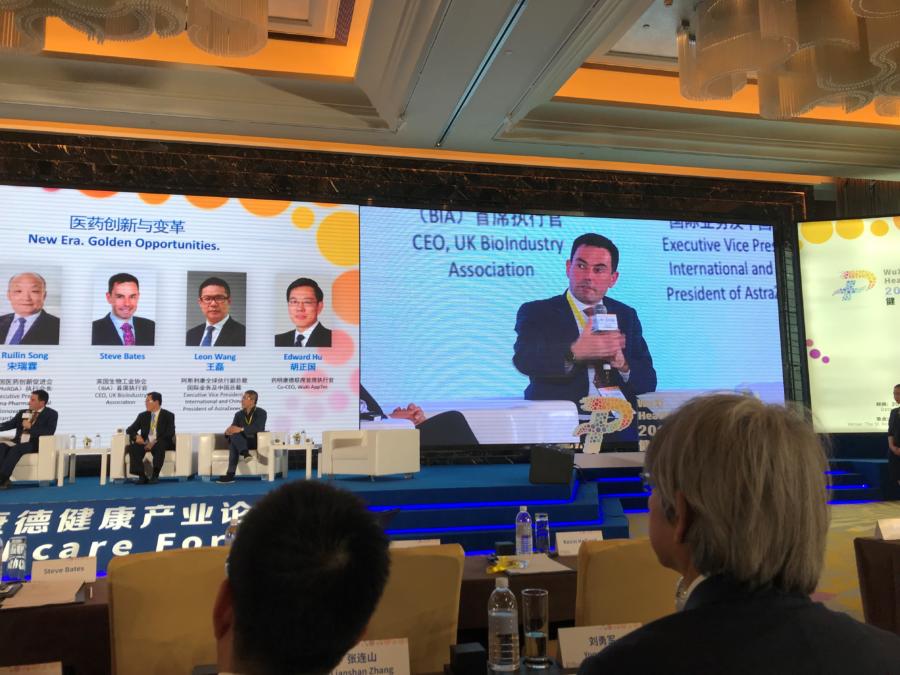Engaging with China | BIA CEO, Steve Bates OBE
I attended and participated in the inaugural WuXi Healthcare Forum in Shanghai in March 2019, enabling me to gain a better insight into some of the key trends occurring in innovative life science in China today. Here are a few thoughts that I came away with.
In the last two years China has made a concerted attempt to, and has delivered, fundamental changes to key aspects of its human healthcare market as part of a broader Government push to improve healthcare for the nation and become a leader in biotechnology. They fall into four areas regulation, reimbursement, talent and capital.

- Regulation of drugs has changed with a new approach from the Chinese regulator The National Medical Products Administration (NMPA)
Since 2017 it has dramatically revamped its processes to eliminate hurdles that previously slowed approvals of non-Chinese drugs. No longer is there the requirement that foreign drug makers can only apply to start clinical trials for a drug in China after it has at least entered phase 2 testing elsewhere. Foreign drug makers can file for a new drug approval using data from international, multicentre trials, so long as those trials include China as a study site. 48 of these have been fast tracked for approval – in weeks not months or years.The NMPA have joined ICH and are keen to take a key role in the global regulatory discussions about the future. There have been recent discussions between the MHRA and the NMPA and the UK’s medicine regulation system and clinical trial capacity is well respected. Despite these policy changes 2019 saw high profile media stories in China about vaccine manufacture failings and falsification of clinical trial data which led to public health issues, huge fines for the firms involved and the dismissal of key officials. Drug safety remains a key issue.
- Re-imbursement procedures have changed for this huge market
Overseen by the The National Healthcare Security Administration (NHSA) and not easily navigable to the uninitiated (show me a market in the world that is ) and with cost containment measures and competitive genericization thinking built in – nonetheless this is a sea change for a globally significant market. In 1996 the value of the China drug market was the equivalent of Belgium. Now new government reimbursement procedure cover 1.4 billion people with GDP growing at 6%, and medical inflation at 10.3%. Key aspects of the system include the development of a National Essential Medicines List (2018). In 2018 this contained 685 drugs, which consist of 417 chemicals and biological products and 268 Chinese patent medicines. The NEML (2018) includes the category of paediatric medications for the first time, 22 urgently needed drugs for children and 12 cancer drugs were added. The new NEML increases drug types, attaches equal importance to Chinese and Western medicine, and highlights the demand for basic medication for common diseases, chronic diseases, heavy burdens, serious diseases and public health. The UK’s Astra Zeneca have benefited from these recent developments and are now the second largest pharmaceutical company in China. Their oncology portfolio is now available in a significant number of public hospitals. Under the dynamic leadership of Leon Wang, AZ have also pioneered a broader approach to innovative healthcare for China – bringing new ideas and demonstrating the importance of primary healthcare, early diagnosis and the management of chronic long term conditions.
- Talent policies to get experienced leaders to return “sea turtles” are working and an ecosystem is developing
For over a decade China has offered significant incentives for Chinese talent to return from overseas to set up and run innovative companies. This has resulted in a lot of talent moving to China-based biotech companies and life science financing roles companies from California, Massachusetts and global pharma. A lot of management teams have been stocked with Chinese executives who have a lot of the transnational experience that investors can back. This group of returners are self-styled “sea turtles” and see and act as participants in a global sector who happen to be based in China. Proud of the rapid development of the sector in China (especially around Shanghai) they have driven the development of the ecosystem in China that is easily recognisable to UK ecosystem players – with financiers, innovative business leaders, smaller and bigger local companies and global companies. The informal BayHelix network is at the heart of this development and this core group have a similar vision to the UK ecosystem of growing , with Chinese characteristics, a globally leading cluster of life science innovation.
Here WuxiAppTec, the key Chinese CRO is playing a nucleating role -with its Healthcare Forum attracting over 5000 applicants of whom over 3000 attended the event in March 2019. (If WuXi apptec is not a company you are familiar with a sense of scale might be helpful to understand. In 2017 it was employing 13,000 scientists out of a total of 22,000 employees. GSK in comparison had 16,000 R&D staff globally in its 38,000 employees.) Increasing trade barriers between the USA and China are a major concern to this group – with SFIUS processes for biotech investment often mentioned. This is not a direct issue for UK/China investment or partnering, but needs to be factored into any global company thinking. The next generation of Chinese students are getting first-rate educations at biomedical research centres in the West and many are at key UK universities, getting to know, like and respect UK science and teaching. As many return to take up roles in the Chinese innovation ecosystem leveraging this cultural and science link effectively should enable the UK to be a key, trusted and respected partner to the Chinese ecosystem.
- Capital and Public Markets
The Hong Kong Stock Exchange rule changes to enable pre revenue Biotech companies to float has resulted in 7 IPOs so far, CStone being the most recent last month. There is a pipeline of more IPO’s expected – even if there are bumps in how the exchange operates and investors immediate experience of the first few IPOs wasn’t immediately profitable. There is also a clear desire from the Shanghai exchange to go in a similar direction. There is a community of sea turtle led investors, in venture capital firms mainly in Hong Kong , where a number of global banks with offices in Hong Kong are driving this development. The best description I heard of the Chinese biotech investment market is that it is not dissimilar to the US (or UK) market of the late 1990s. Confident, expecting growth, increasing in sophistication but still young and growing. Buoyed by domestic market growth (see reimbursement policy changes above) and new scientific opportunity, there is a significant pool of capital seeking to invest in biotech and related innovative healthcare. Key UK pioneers have engaged with this group and I believe that with continued engagement Hong Kong based investment money, or even an IPO, might be a route for scaling innovative UK based life science companies to explore.
Want to know more, how best to engage?
The UK Government’s Life Science team (normally based in China) are doing a roadshow across the UK through March and places are available at some of their events – this is a good way to meet a team whose job it is to help UK life science companies grow and have practical experience of making things happen on the ground in the last year or so. You can sign up here and they are also planning on doing a newsletter.
The BIA’s China Special interest group, which is open to BIA and CBBC members, continues to meet and share experience of UK and China life science opportunities. Future events for the group can be found here and for further information please contact Alex Whicher.
The BIA took a UK delegation to BioCentury and BayHelix’s China Healthcare summit in November 2018 and plans to do so for this year’s event which will be held in Shanghai 18-20 November 2019. Again please contact Alex Whicher if you are interested in joining.
Building a strong bridge linking the UK and Chinese innovation ecosystem remains a core priority for the BIA through 2019. I would welcome comment and insight from UK players who are also active, or considering becoming active in China – whether through partnership, investment or at this stage interest. What can we, as your association, do to help you when it comes to China? – please drop me a line.
More within
- Regulatory
- Finance Tax Investment
- Pre Clinical And Clinical Research
- Manufacturing
- Overarching Political Issues
- Strategic Technologies
- Skills People And Talent
.png)
.png)
